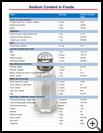
Salt in the Diet
________________________________________________________________________
KEY POINTS
- The cells of your child’s body need sodium to work properly and keep the right balance of fluids.
- Too much salt can cause health problems.
- Cut back on salt by using less when you cook, and helping your child eat more fresh fruits and vegetables and fewer snack foods.
________________________________________________________________________
What is salt?
Salt used in the diet is a mineral called sodium chloride. Salt comes from seawater and from underground deposits. Your child’s body needs sodium to stay healthy.
- The cells of the body need sodium to work properly. Too little or too much sodium in the blood can affect brain, heart, nerve, and muscle cells.
- Sodium helps your child’s body keep the right balance of fluids. The right fluid balance helps the body keep the right blood pressure, keeps your child from losing too much fluid (dehydration), and keeps your child’s kidneys healthy.
Too much salt in your child’s diet can lead to too much sodium in the blood and cause health problems. For example:
- Your child’s body may keep too much water. This may cause swelling of the hands, feet, and belly.
- Your child’s blood pressure may get too high. High blood pressure increases your child’s risk for heart disease and stroke.
How much salt does my child need?
The amount of sodium your child should have is based on age. Your child should have no more than:
- 1500 mg for children aged 1 to 3
- 1900 mg for children aged 4 to 8
- 2200 mg for children over age 9
How do I lower the amount of salt in my child’s diet?
If your child takes medicine or has any medical problems, be sure to check with your healthcare provider before you change your child’s diet. Sodium is found in many foods. Adding salt to food adds more sodium. Here are ways to decrease the salt in your child’s diet:
- Serve more whole foods like fresh fruits and vegetables, which have very little sodium.
- Use little or no salt when you prepare food. Try flavoring food with herb and spice mixes or salt substitutes that do not contain sodium. Avoid seasoning mixes that may have salt in them, such as lemon pepper, Cajun seasoning, and blackening spices.
- Do not add salt to food at the table.
- Read the labels on all canned, packaged, or frozen foods to see how much sodium they contain. Many soups, frozen dinners, lunch meats, flavored potato, rice and noodle mixes, and other processed foods have a lot of sodium. Be aware that food labels list sodium rather than salt content and the amount is always given in milligrams (mg). Foods that have less than 140 mg sodium per serving are considered to be low in salt.
- Check the sodium content in snack foods, even things that don’t taste salty.
- Don't use a lot of sauces or condiments such as ketchup on foods.
After your child has been on a low-sodium diet for a while, his sense of taste for salt will change. For most children, this takes about 30 days, so it is important to stick with it. There’s a good chance you will find that your child enjoys eating foods that have less salt and are less processed. Some foods, like canned soups and packaged meats, may start tasting too salty.
To learn more about cutting down on sodium, see:
- USDA National Nutrient Database
https://ndb.nal.usda.gov/ndb/ - National Heart, Lung, and Blood Institute
https://www.nhlbi.nih.gov/health/educational/healthdisp/pdf/tipsheets/Choose-Foods-Low-in-Sodium.pdf
Last modified: 2017-05-08
Last reviewed: 2017-05-08

